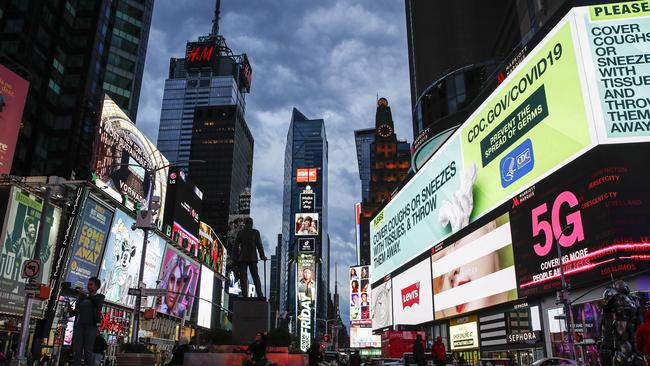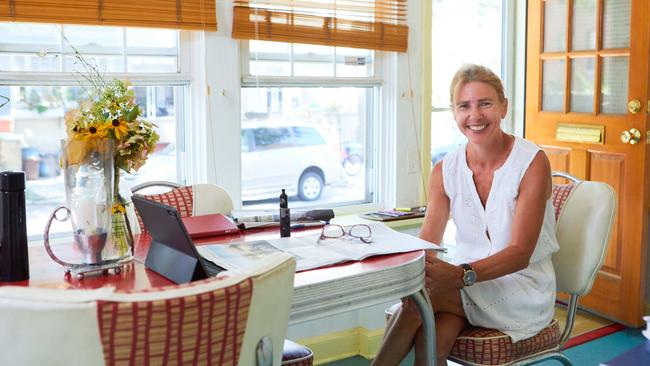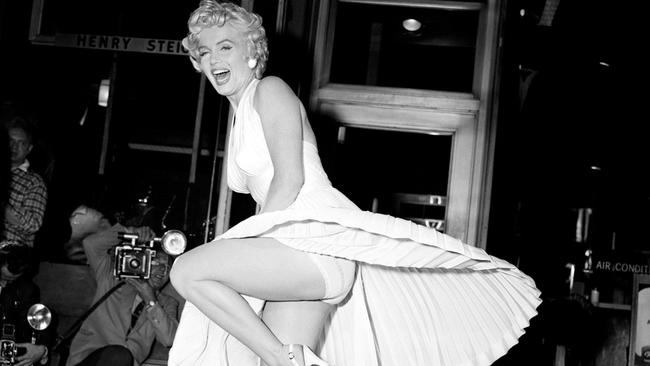How the coronavirus pandemic has tarnished Hollywood and New York
America’s mishandling of the coronavirus pandemic will tarnish its reputation as a cultural mecca — and it may never recover.

New York is the world’s most cinematic city. Its yellow taxis, thrusting skyline and great green lung that is Central Park have provided backdrops to hundreds of movies and television series, from Woody Allen’s Manhattan, a black-and-white homage to the controversial director’s home town, to TV series Gossip Girl and Seinfeld. Then there is the 1933 film King Kong, in which the lovestruck silverback scales the Empire State Building and beats his chest, as if in defiance of the society that exploits and destroys him.
That art deco, high-rise beauty has more than 200 screen credits, reflecting how New York is not just a key commercial and cultural centre but a state of mind, familiar even to those who have never been there. Who hasn’t seen the Lexington Avenue publicity still for The Seven Year Itch, in which Marilyn Monroe’s white halter dress is whipped up around her thighs by surging air from a subway train? Or the Katz’s Delicatessen scene where When Harry Met Sally’s “I’ll have what she’s having” gag plays out? Even when darker films such as The Godfather trilogy, Taxi Driver and Wall Street have exposed New York’s underbelly of violence, sleaze and avarice, the city emerges as addictively edgy rather than a destination to scratch from the bucket list.
How could it not? Although it’s overpriced, crowded, humid in summer and bitingly cold in winter, for almost a century the myth-makers consciously positioned the city as the ultimate proving ground for strivers and dreamers; as Sinatra growled in the anthemic New York, New York: “If I can make it there / I’ll make it anywhere.” The same dynamic is at work in the feel-good 42nd Street, the Depression-era film musical (later adapted for the stage), in which novice chorus girl Peggy Sawyer steps into the gold tap shoes of the injured leading lady and is told: “You’re going out a youngster but you’ve got to come back a star!”
Given how it has long been cast as the ideal metropolis, it’s disconcerting to witness how the coronavirus pandemic has forced the city that never sleeps on to its knees. As the virus ravaged the globe, by early last month New York State had recorded more cases (160,000) than any country (apart from the US itself), according to the BBC. By this month, the US had well over one million coronavirus cases — again, far more than any other nation.
Mass graves being dug in public parks, refrigerated trucks doubling as morgues, the newly unemployed queuing for emergency food parcels and armed protesters storming a state government building are not the images one expects to see in a developed nation, let alone one that is a superpower, often defined by its two hugely influential cultural centres — Hollywood and New York.
While it’s true the US per capita virus death toll is lower than those of Britain, Spain or Italy, only in the US — the true home of self-boosterism — has the pandemic sparked an existential crisis. The June edition of The Atlantic magazine is running the devastating headline “We are Living in a Failed State” and, under it, staffer George Packer writes: “When the virus came here, it found a country with serious underlying conditions, and it exploited them ruthlessly. Chronic ills — a corrupt political class, a sclerotic bureaucracy, a heartless economy, a divided and distracted public — had gone untreated for years … The crisis demanded a response that was swift, rational, and collective. The United States reacted instead like Pakistan or Belarus — like a country with shoddy infrastructure and a dysfunctional government whose leaders were too corrupt or stupid to head off mass suffering.”
Given this grim reckoning, the effects of the pandemic on the US’s cultural sector go deeper than the potentially ruinous financial losses that will flow from state lockdowns and shuttered theatres, cinemas and museums. America’s mishandling of the pandemic raises the question: Will the nation that has long defined itself as the epicentre of the contemporary art, theatre, television and film worlds permanently lose its lustre and cultural swagger?
Aaron Nyerges, a lecturer with the University of Sydney’s US Studies Centre, agrees “the images coming out of New York, the depth of the impact that the pandemic has had on American society, is going to tarnish its image and maybe some of the lustre of the more glamorous associations we have with the theatre or the art world in New York or the Hollywood star system. This could potentially tar the nation with one brush.”
However, as the pandemic plays out, he cautions that “everything comes with a wait and see caveat”.

London-based American novelist Lionel Shriver tells Review she is dreading what she will find in New York this year, if and when she and her husband return for their annual visit. The Orange Prize winner’s 2016 novel, The Mandibles, is a satire in which the US suffers such a profound economic collapse, even the upper middle class ends up living in tents in a Brooklyn park. “We always spend the summer in Brooklyn,” Shriver says, “and I dread going back to the city this year. I expect bank upon bank of shuttered properties all over the five boroughs. Oh, the Met and the Modern (Museum of Modern Art) will survive, but the lower-level, ultimately more vital cultural institutions could be eviscerated.”
The writer and columnist, whose new novel, The Motion of the Body Through Space, skewers the contemporary fitness cult, reflects that even before the pandemic, the Big Apple was losing its sheen: “I’m especially concerned about New York City because it was already suffering from a steady degradation of what once made the place so distinctive. The rents went so high in Manhattan that only designer outlets and chains could afford them, and so many small independent shops and restaurants vanished. I’m afraid that the coronavirus will finish the job. My husband is a jazz musician, and the few remaining venues in New York where he plays are likely to be bankrupted.”
Many US states have partially eased their lockdowns, but New York city’s “pause’’ on non-essential businesses continues, meaning that Broadway theatres and the Metropolitan Museum of Art have no firm dates for when they can reopen. Local media have reported that Broadway venues might reopen their doors in July, but only if the city reaches the final stages of its reopening strategy by then, while British producer Sir Cameron Mackintosh warned these theatres (along with London’s West End) might stay dark until early next year. “If we don’t hear (about lockdowns lifting) in a few weeks, I think the truth is, we won’t be able to come back until early next year,” he told the BBC.
The Met is grappling with a serious funding shortfall and job losses in addition to the 81 positions it has already cut. As the Art Newspaper reported: “In an ominous bellwether for US institutions, the mighty Metropolitan Museum of Art … announced a projected $US100m ($155m) shortfall (covering this and the next fiscal year) just six days after it closed on March 12. (It now says that amount could swell to $US150m.)” While July has been mooted as a possible reopening date, the Art Newspaper says “some expect that date to be pushed back”. Another shuttered New York institution, the American Museum of Natural History, is to slash about 200 jobs, while Carnegie Hall has cancelled the remainder of its 2019-20 season.
California may have managed the pandemic better than the northeastern states by implementing social-distancing measures sooner, but make no mistake: Hollywood is reeling. The virus-induced closure of cinemas worldwide, halting of film production and lengthy delays to the year’s biggest releases, including Fast & Furious 9 and the latest Bond film, No Time to Die, may cost the industry billions of dollars, and there are predictions some screen businesses may not survive.
Amid media reports of Hollywood facing its “worst nightmare” as the pandemic entrenches streaming services and home viewing, Universal Studios last month released the children’s movie Trolls World Tour digitally. Universal signalled that in future it might release its films simultaneously online and in movie theatres, setting off a furious row with cinema operators who usually get first dibs on Hollywood movies.
Nyerges says the pandemic is forcing studios and Hollywood’s old guard “into a kind of begrudging relationship with streaming media services, which are a competitor, but increasingly there’s a co-dependence between the two”. In the pandemic’s wake, eligibility requirements for the Oscars have been loosened to allow films released through streaming or video-on-demand services to go into the running for the coveted statuettes, without first screening in a Los Angeles area cinema.
Kendall R. Phillips, professor of communication and rhetorical studies at Syracuse University, argues that Broadway and Hollywood can bounce back from the pandemic but will undergo radical change. “I don’t think post-pandemic American arts will look anything like it did before,” he tells Review. “I think there are gonna be substantial changes in terms of … the way it attracts an audience. It’s going to be harder for them to bring people into theatres the way they have in the past.” While states such as Georgia and Texas have allowed cinemas to re-open, many anxious theatre owners have so far refused to take that step.
Professor Phillips says Hollywood studios also will find it harder to make money from their $US250m event films — the Bond and superhero franchises — which usually return big profits by screening at multiplexes around the world. (While some cinemas have reopened in China, film fans were initially too fearful to go to them in significant numbers.) Phillips says: “The streaming services are probably, at least for the short term, winning the war (with the studios). They are dominating and are likely poised to continue that dominance.”
Can Hollywood recover from the financial losses caused by delayed film releases and cinema closures?

“No,” the academic says bluntly. “You probably will see some studios either scaled down or you’ll get more mergers.” Because the pandemic has shut down new film production, the most durable Hollywood businesses will be those that have “big back catalogues of content. In the streaming era, content is king.” He says such companies may include Netflix, Amazon and Disney+, while the upstarts “who may or may not succeed” (because they focus heavily on new content) include Hulu, maker of The Handmaid’s Tale, and Apple TV+. “You’re (also) looking at the traditional producers of big-screen entertainment that are really going to struggle to recapture audiences,” he says.
Phillips likens the US health crisis to “a very strange, slow-moving train wreck”. After the 9/11 terror attacks, he says, “at least initially Americans rallied together around the tragedy, and here it (the pandemic) did not take long for Americans to fall into some pretty unpleasant partisan bickering, which again is not the image the country has of itself”.
Have the glamorous reputations of Hollywood and New York been tarnished as a result? He says they have, though he points out that in the 1970s and 80s (when crime rates were high) New York’s reputation was far less romanticised than it is now. “You certainly had the (romanticised) Woody Allen version of New York … but you also had the grittier, rougher version of New York which was Death Wish and Escape From New York and any number of (variations on) the mean streets of New York.” Post-pandemic, he predicts, “the city will still be pretty iconic but … it may not be the Big Apple, it may be a little more the rotten apple”.
Don’t write off the Americans, yet, Nyerges insists. He notes how, in this era of live cultural content going digital, whenever an Australian theatre company puts a show online, they are “beaming that out to people through an American company like Instagram. So there’s still a sense in which American influence and the primacy of American companies is maintained. Netflix is making hay at the moment … The importance of Hollywood and American film production is being reasserted as it’s being compromised, strangely enough.”
He grew up in a rural area of New York State and says its biggest city “has always been a grit and glamour place. There’s always been this romance of New York, that it’s a place where you can get knocked down and get back up again. It’s the spirit of the city — that it’s not an easy place to live — but that’s also what makes it an exciting place to live.”
Nonetheless, he has found some of the pandemic images emanating from there “intensely shocking”. His academic research takes him to New York regularly, and while he is drawn to its irrepressible energy, he feels many Americans harbour a “sense of sadness and even a kind of embarrassment: how could a city and a society that holds itself in such high esteem, face such grave challenges?”. It’s a good question, and one the rest of the world is asking, too.
RELATED: Why the elbow bump is the most ridiculous greeting in history | A pandemic good for art? The Spanish flu tells a different story | Can the hairdresser do my colour yet? How corona-recovery looks




To join the conversation, please log in. Don't have an account? Register
Join the conversation, you are commenting as Logout